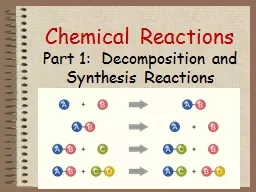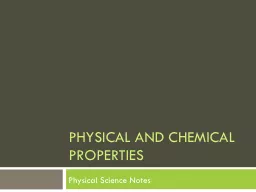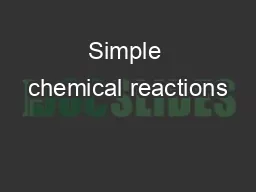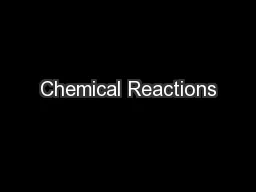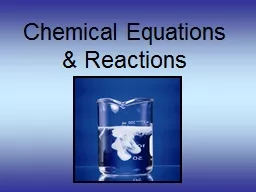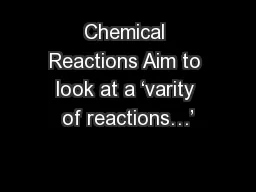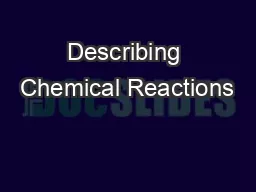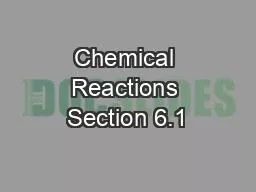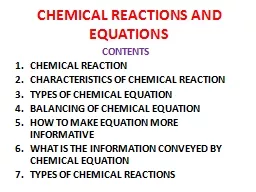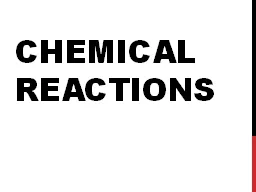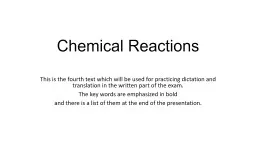PPT-Chemical Reactions
Author : luanne-stotts | Published Date : 2016-10-08
Part 1 Decomposition and Synthesis Reactions Objectives To identify decomposition and synthesis chemical reactions To predict the products of these two types of
Presentation Embed Code
Download Presentation
Download Presentation The PPT/PDF document "Chemical Reactions" is the property of its rightful owner. Permission is granted to download and print the materials on this website for personal, non-commercial use only, and to display it on your personal computer provided you do not modify the materials and that you retain all copyright notices contained in the materials. By downloading content from our website, you accept the terms of this agreement.
Chemical Reactions: Transcript
Part 1 Decomposition and Synthesis Reactions Objectives To identify decomposition and synthesis chemical reactions To predict the products of these two types of reactions 2 Symbols in . DEFINITIONS AND TYPES. Revision:. DO NOT WRITE- FOR YOUR INFO ONLY. We have looked at the period table, what atoms are, elements and compounds. You have learnt that atoms can join to make compounds or molecules and that we can mix compounds to make new compounds…..these are chemical reactions. Physical Science Notes. Physical Properties. PHYSICAL PROPERTY . - A feature or characteristic of matter which can be observed without changing the identity of the matter . Examples. :. . . Color. Chemical change. . Reactions with acid. . Reactions with oxygen . 7F. 7F Simple chemical reactions. Chemical change. . 7F Simple chemical reactions. 7F Chemical change – Changing materials. How many different materials can you see in this bedroom?. Chemical Reactions. Investigation One. Chemical compounds are formed when two or more elements combine.. H. ₂ + O . H₂O (water). Na + . Cl. . NaCl. ( Sodium Chloride – Salt). Chemical Compounds. 1 – Nature of Chemical Reactions. 2 – Chemical Equations. 3 - Reaction Types. 4 – Reaction Rates and Equilibrium. State Standards. CLE.3203.1.9 – Apply the Laws of Conservation of Mass/Energy to balance chemical equations. Chemical Equations. This equation means:. 4 Al(. s. ) + 3 O. 2. (. g. ) 2 Al. 2. O. 3. (. s. ). 4 Al atoms + 3 O. 2. molecules yield 2 molecules of Al. 2. O. 3. 4 Al . moles. Synthesis reactions. Decomposition reactions. Single replacement reactions. Double replacement reactions. (Precipitate reaction). Chemical Reactions can be written as:. Word equation. Chemical equation. Add the new notes to your . table of contents. , and then turn to the next clean page and set up your title and date. Tape the two slides into your INB flat down, directly under your title - they do not need to flip up. Chemical Reactions. A chemical reaction . is the process by which one or more substances change into one or more new substances.. Reactants . are the original substances in a chemical reaction.. Products . THINK ABOUT IT . Living things are made up of chemical compounds, but chemistry isn’t just what life is made . of—chemistry is also what life does. . . Everything that happens in an organism. —its growth, its interaction with the environment, its reproduction, and even its movement. Chemical reactions. A . chemical reaction . is when one or more substances change into different substances. . Example . iron + sulfur . iron (ii) sulfide + energy. Go to textbook Page 225. Read page 225 and write definitions for the following into your notes.. CONTENTS. CHEMICAL REACTION. CHARACTERISTICS OF CHEMICAL REACTION. TYPES OF CHEMICAL EQUATION. BALANCING OF CHEMICAL EQUATION. HOW TO MAKE EQUATION MORE INFORMATIVE. Changes or transforms chemicals into . other. chemicals. Ex: Iron + Oxygen . . Iron Oxide (rust). Physical Science Review. What is the product?. What are the reactants?. Chemical formula. . shows the kind and proportion of atoms of each element that occurs in a particular compound. The key words are emphasized in bold . and there is a list of them at the end of the presentation. . Chemical Reactions. When a chemical reaction occurs, new substances (called . products. ) form from the substances taking part in the reaction (called .
Download Document
Here is the link to download the presentation.
"Chemical Reactions"The content belongs to its owner. You may download and print it for personal use, without modification, and keep all copyright notices. By downloading, you agree to these terms.
Related Documents

